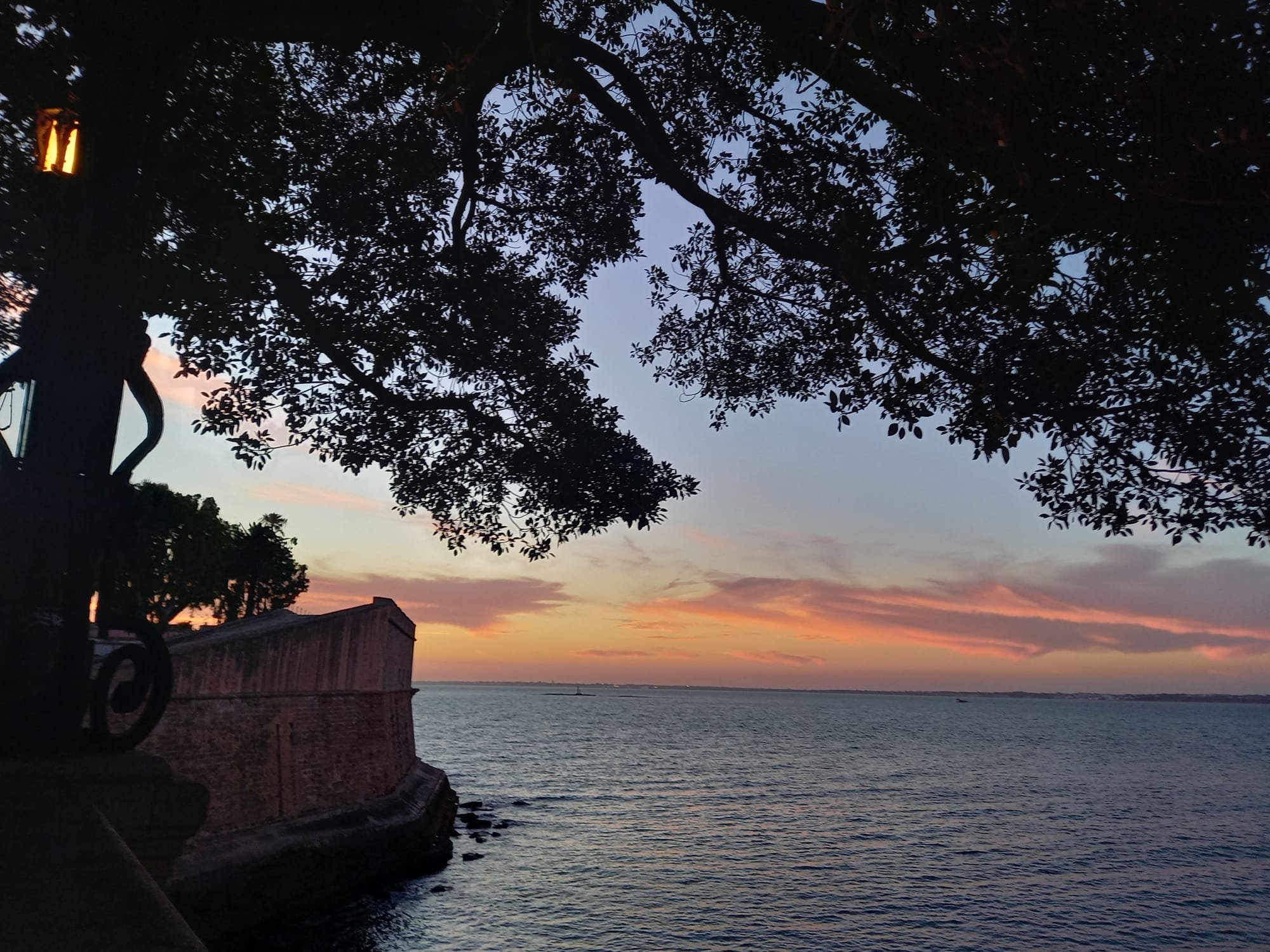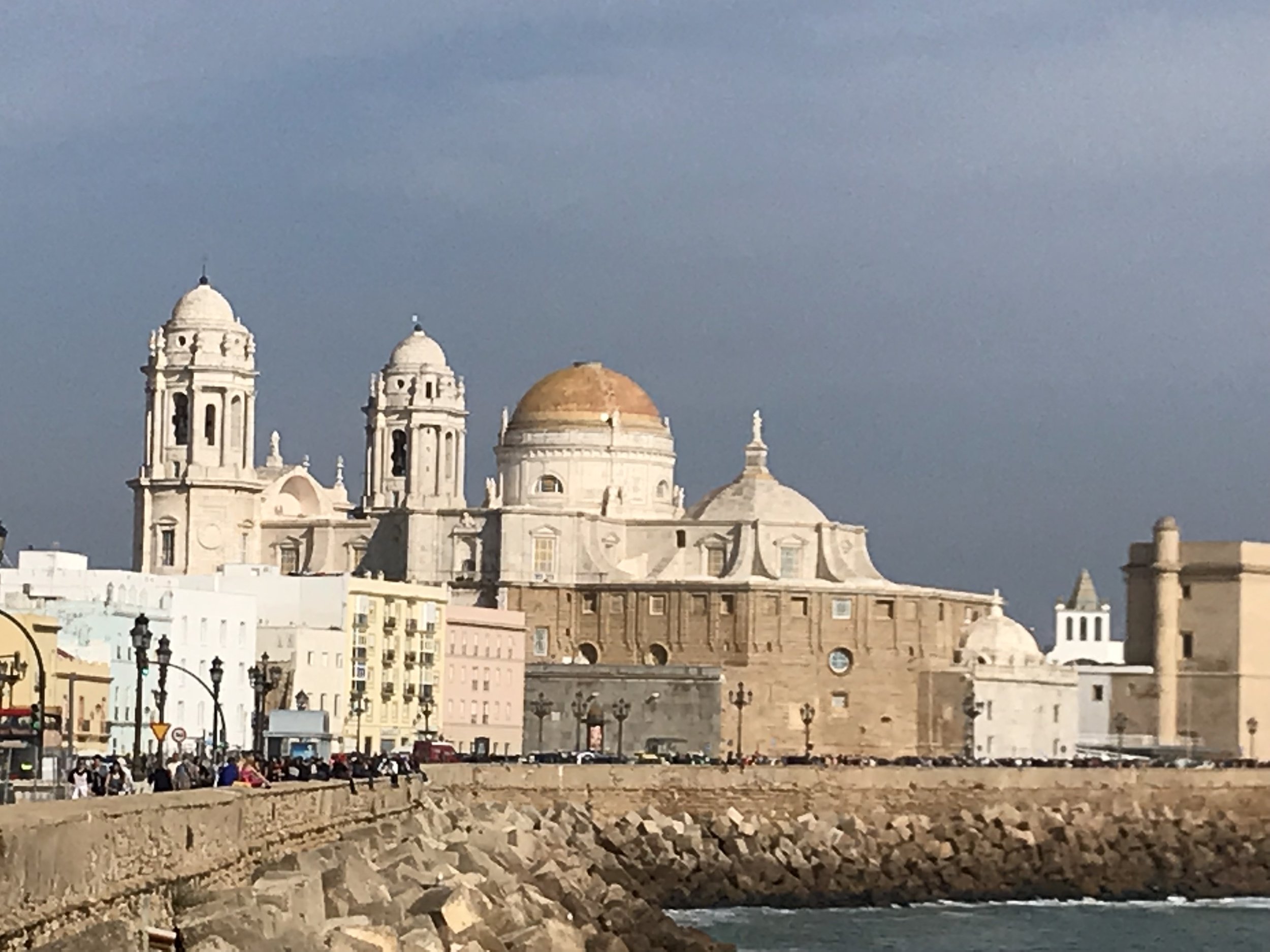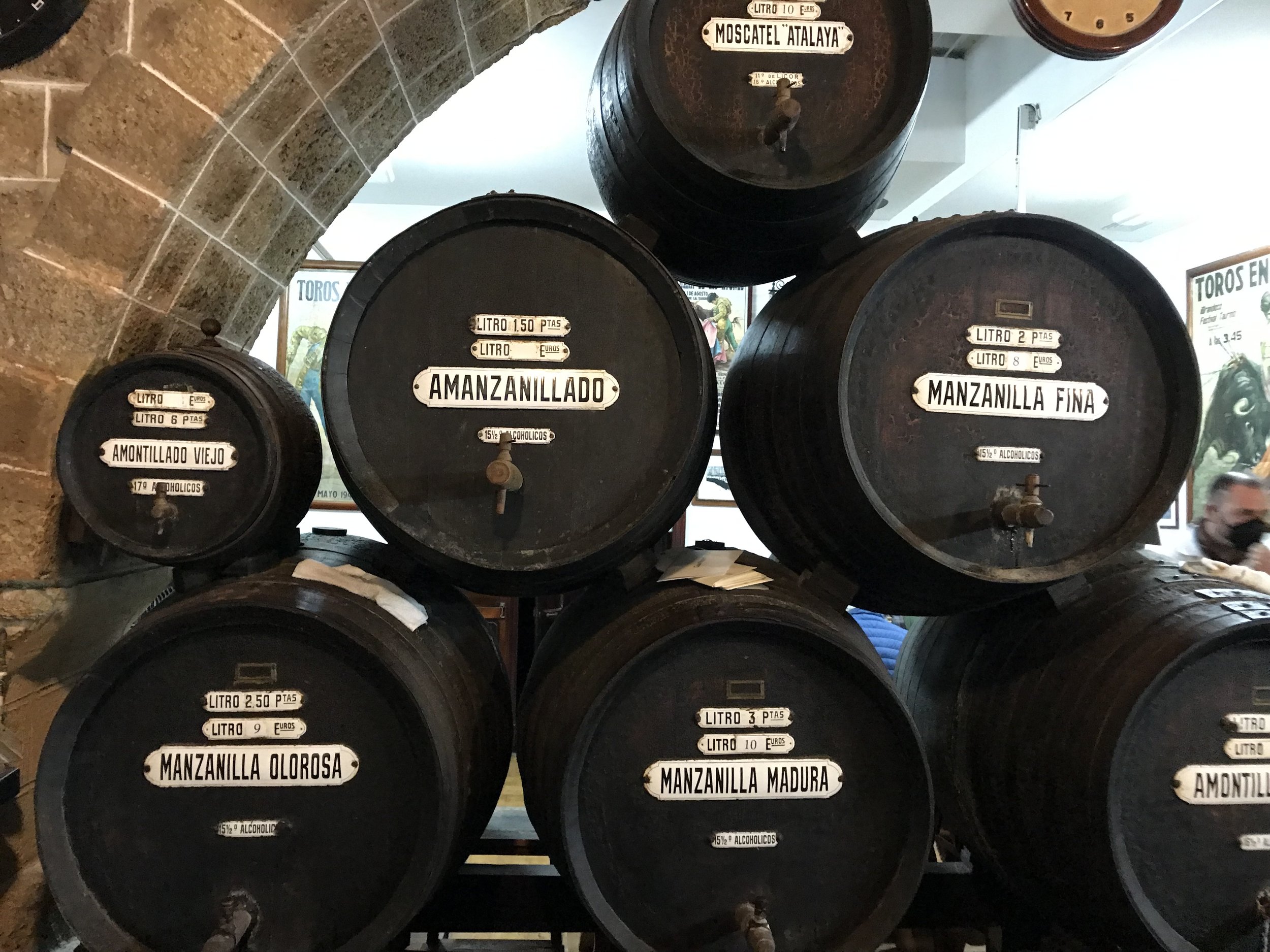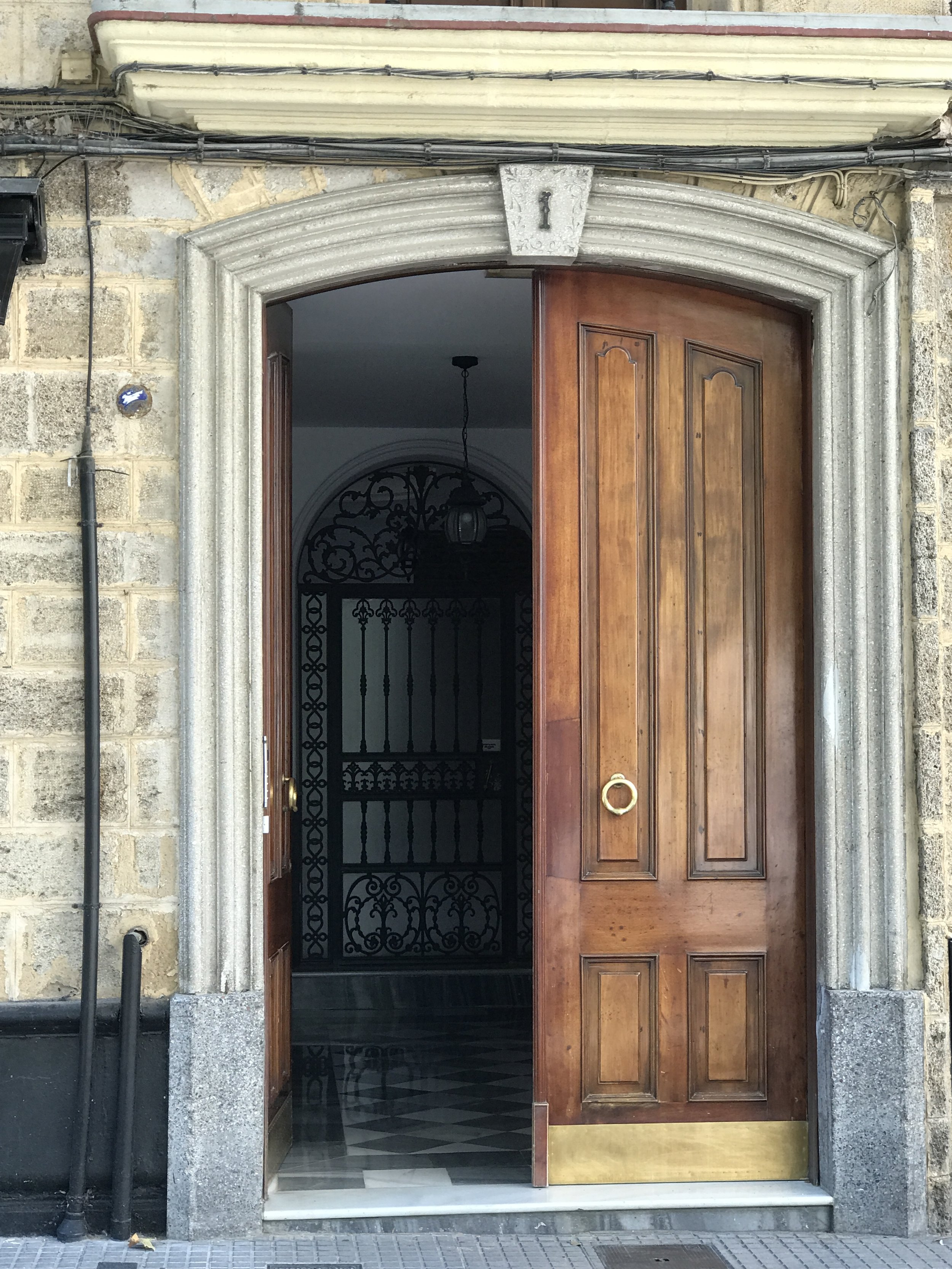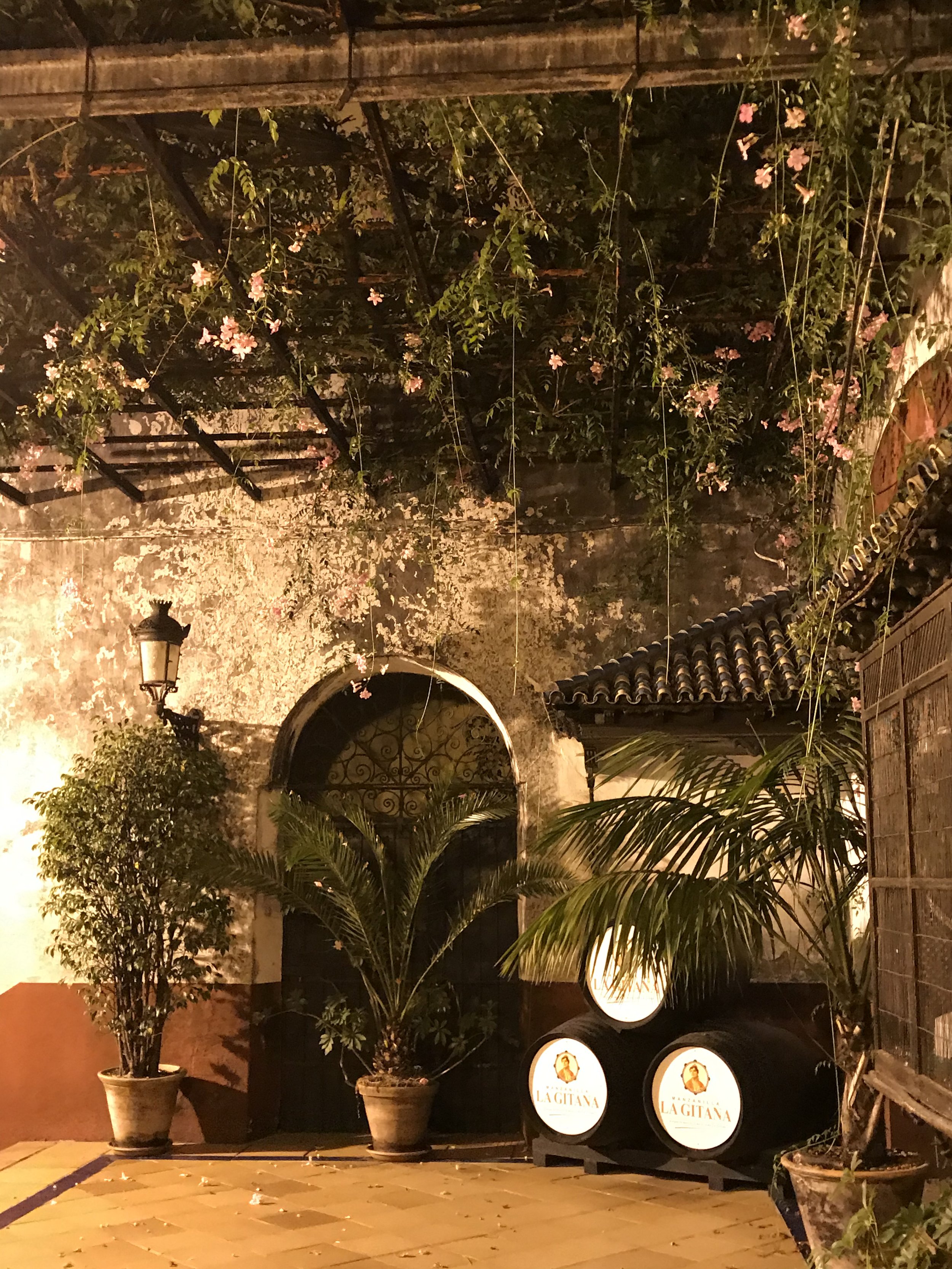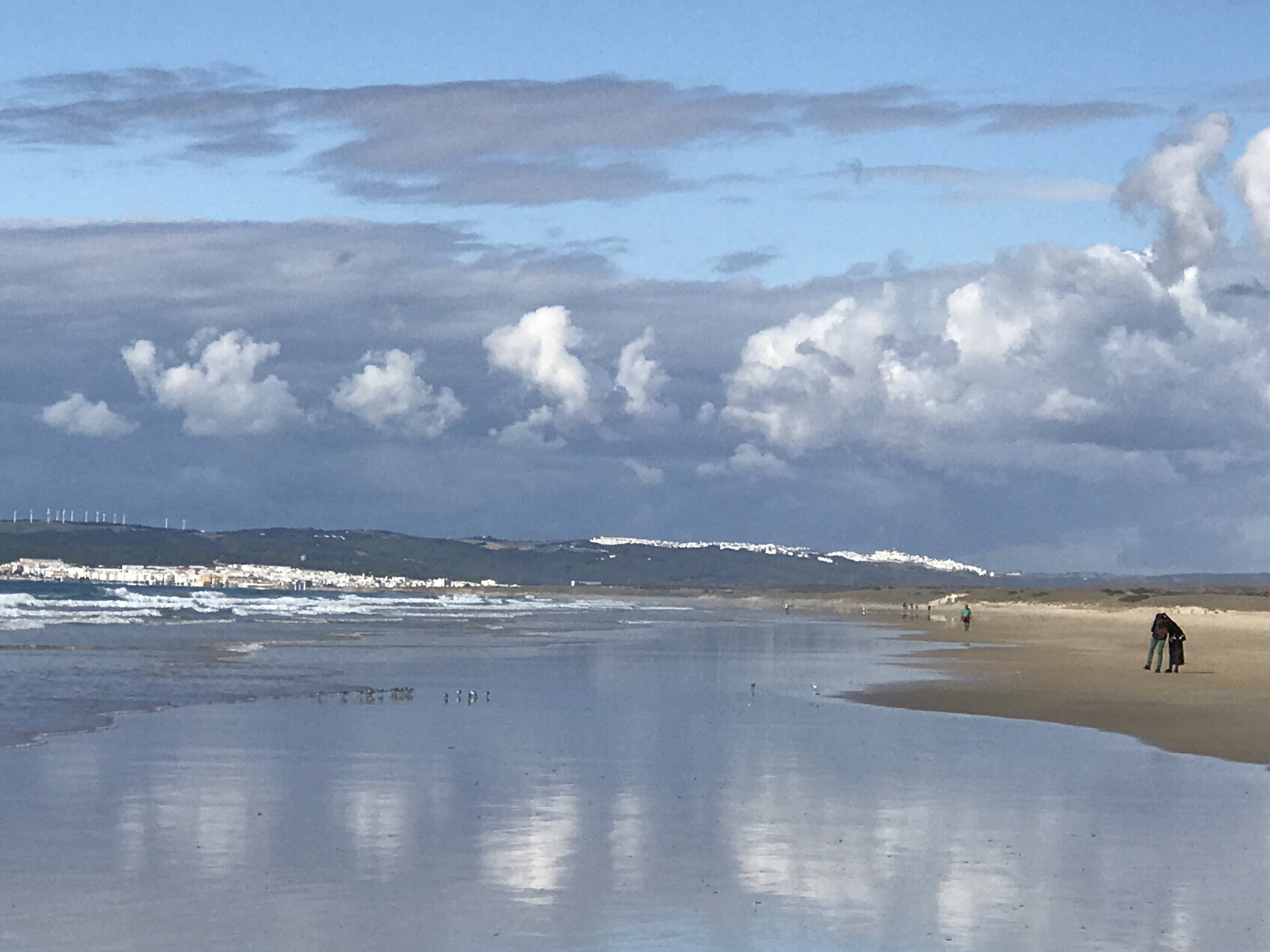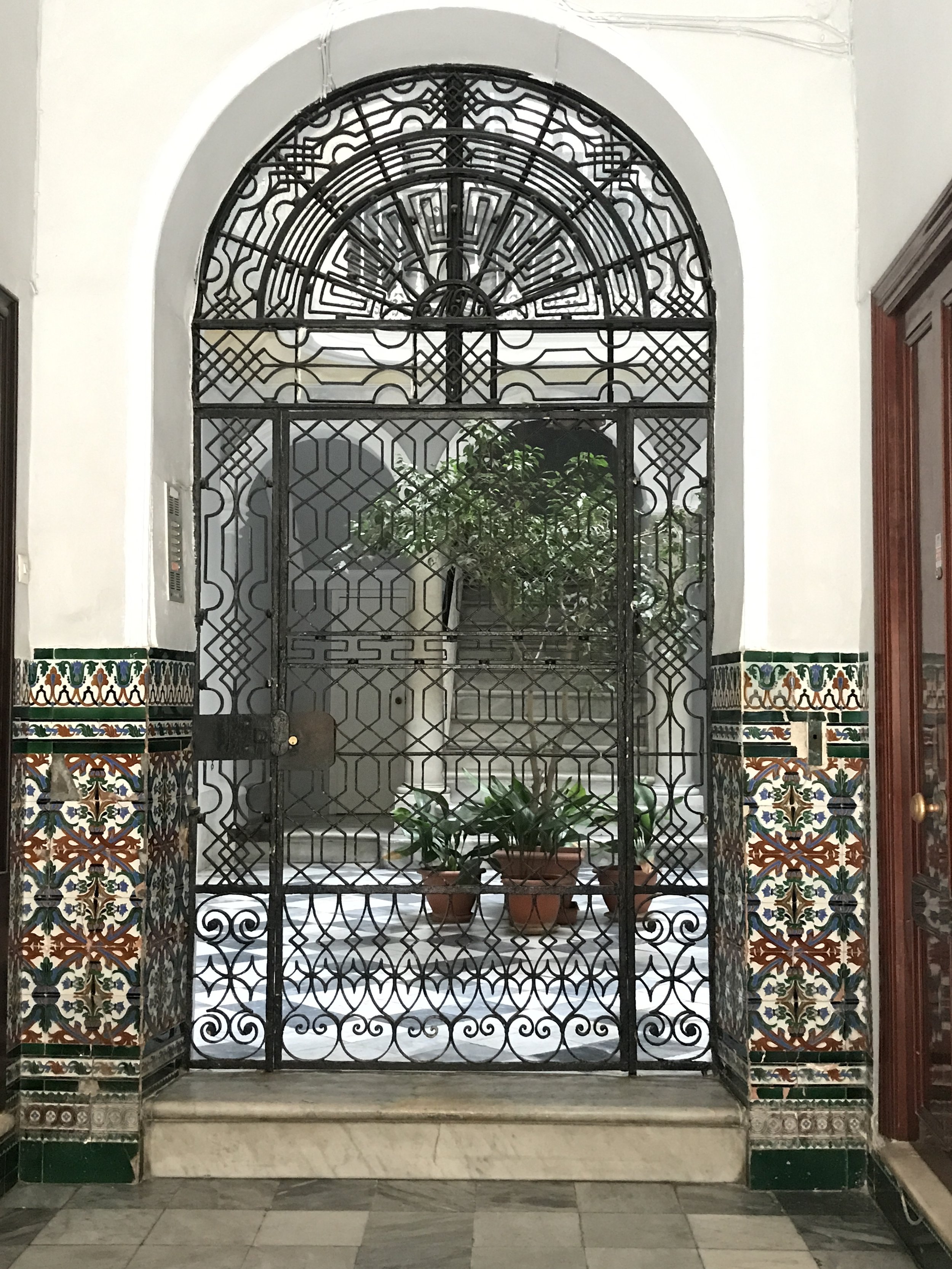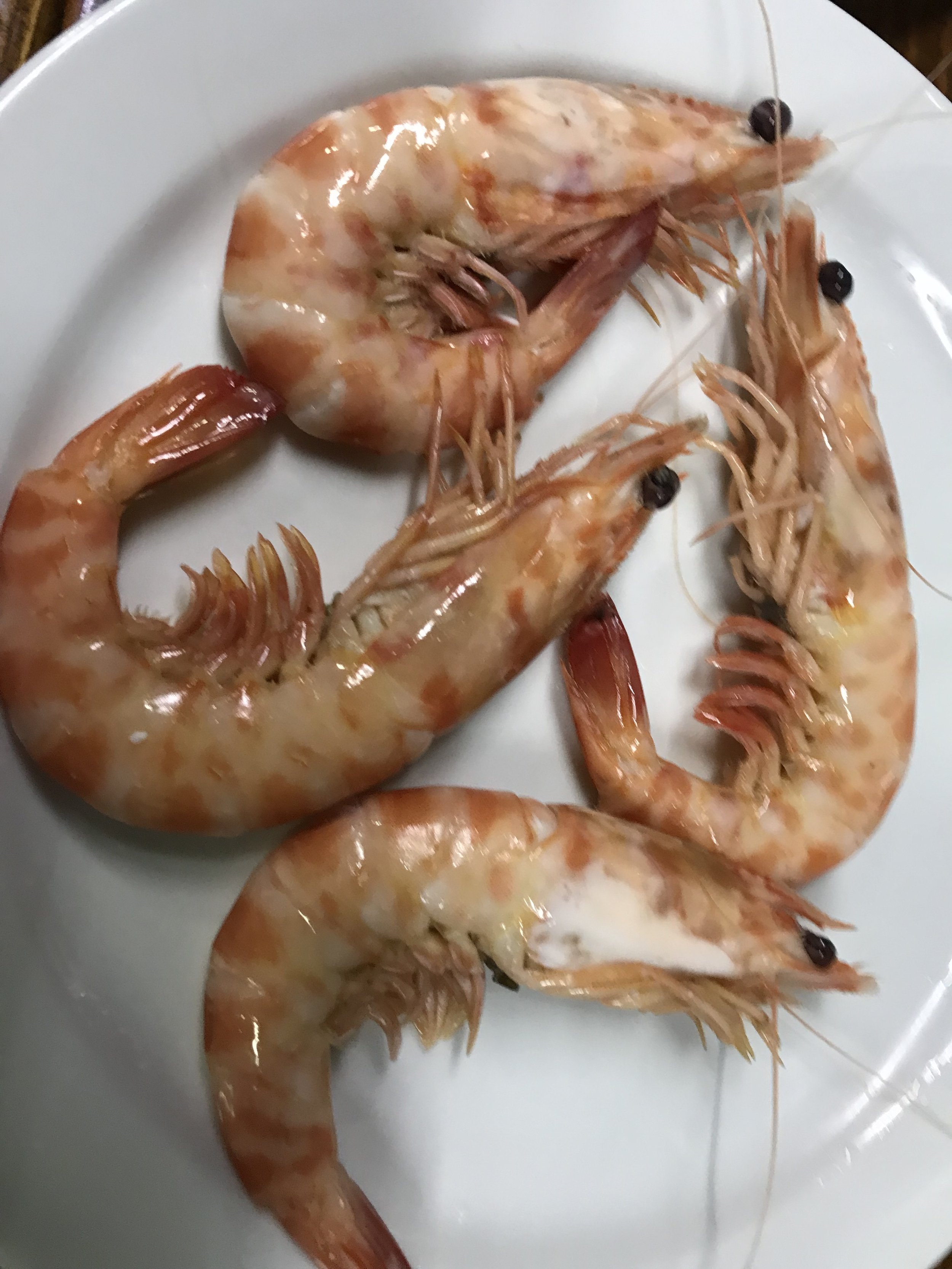The Coast of Light: Cádiz & Vejer de la Frontera Trip
Your week in this unspoiled corner of southern Spain will surely reset the compass. What’s the draw? The Costa de la Luz´s (Coast of Light) stunning, wide Atlantic beaches, seafood from local waters prepared without fuss and two charming Andalusian towns to discover: the city of Cádiz and the white village (pueblo blanco) of Vejer de la Frontera. This is a week for wanderings, long lunches, wine tasting–indulgence without complications or requirements. The trip balances private guided experiences with time for you to explore at your pace. A perfect getaway.
Cádiz is unspoiled Andalucía, from the food to the city streets lined with 18th-century merchants’ homes and old-world tapas bars to the enormously long stretches of beaches all the way down to the Straits of Gibraltar. Fish and seafood are what you want to eat here, as the province’s coast is dotted with fishing ports.
To that end, you will visit the glorious Cádiz fish market, and eat at restaurants and bars where local shrimp and langostinos, squid and all its relatives, clams and ocean fish such as sole and sea bass from the day’s catch are served up in small (tapas) or large (raciones) portions.
Above all eating in Cádiz is uncomplicated and festive. You’ll explore the city’s taverns and ultramarinos–store bars–to try the local Manzanilla sherry and the local cured meats and cheeses. A private wine tasting will initiate you into the new white wines of Cádiz which suprisingly are not sherries. After a tasting at a renowned winery in Chiclana de la Frontera, you will be sherry initiated.
From Vejer de la Frontera, your hilltop pueblo blanco home for three nights, you can see the Atlantic, and on clear days you can make out the coast of Morocco! Your time in the village will be spent walking the narrow streets–a legacy of Moorish times–learning about the local products on a tapas tour, eating at the restaurant known for the locally caught blue fin tuna, and spending a day at the beautiful Zahara de los Atunes beach. If the best trips reset your thinking, this deep immersion into exotic Cádiz will do just that.
Trip At A Glance
7 Days / 6 Nights
Days 1 - 3 in Cádiz
Take a private walking tour around one of the densest cities in Europe. Our favorite local will tell you about the history as a trading city and share tapas with you at Cádiz’s market. You will try the latest releases of the new wines from Cádiz, made in the ancient styles. Cádiz restaurants range from old-school tabernas to seafood-rich classic restaurants. New on the dining scene are the places opened by young chefs returning home after working in top restaurants in Madrid, Barcelona and the Basque Country, heating up the culinary potential of Cádiz, Vejer and the Costa de la Luz.
Days 4 - 6 in Vejer de la Frontera
Vejer de la Frontera is one of the most visually spectacular of Andalucía’s white villages. It is perched on a hill with views over the surrounding countryside and down to the nearby virgin beaches of the Costa de la Luz (Coast of Light). If an “escape” to exotic surroundings–most notably in spring and fall with the crowds gone home–village streets traced by Moors centuries earlier, lovely beach days and dinners in village-house restaurants appeal to you, this is the place.
The Coast of Light: Cádiz & Vejer de la Frontera Trip
Day 1 - Cádiz Seafood, Tapas and Taverns
Arrival in Cádiz
Cádiz walking tour, taberna stop & market tapas
Free time
Dinner at Casa Lazo Restaurant
Overnight Hotel Casa Cánovas, Cádiz
Andalusia
Covering most of the southern part of Spain, Andalusia holds a charm that no other Spanish region can claim. It is, after all, the ancestral home of so many Spanish images–flamenco, Andalusian horses, bullfighting, sherry and tapas like pescaíto frito, the fresh quick-fried fish so ubiquitous in the south. Even by Spaniards, Andalusia tends to be painted as a single culture and destination, but in truth it’s perhaps the most varied part of the country. The wild coast of Huelva and Cádiz, with windswept beach bars and fresh seafood. The classic inland Andalusian cities of Sevilla, Jerez, and Córdoba, which are sisters but differ so much in their culture, food, history, and atmosphere. The mountain hideaway of Granada, the coastal metropolis of Málaga, the white villages of the mountains. To those with some experience in other parts of Spain, coming into contact with deep Andalusia is a revelation, like discovering a new world that begins south of Madrid.
Cádiz
The city of Cádiz lies on the end of an island extending into the Atlantic Bay of Cádiz, leaving the beautiful historic center with water on three sides. Here you will find colonial-style buildings from the 18th and 19th centuries, many built after the city was damaged by the Lisbon earthquake of 1755 and during its days as the center of trade with the overseas Spanish Empire. The small beach of La Caleta in the city center has stood in for Havana in films. Despite its historic architecture, Cádiz is a dense, living city with lively bars and restaurants extending through its old quarter and down along its long, sandy beaches. It’s the perfect place to get away from the heat of summer and the cold of winter, a world of its own that looks out onto the Atlantic rather than towards Madrid.Vejer de la Frontera
The towns of San Fernando, Puerto Real, El Puerto de Santa María, and Rota line the Bay of Cádiz, each with its own seaside character. Heading south towards Gibraltar lies the Costa de la Luz, with spectacular unmarred beaches and some of the sunniest weather in Spain. Excellent fresh-caught fish and shellfish are abundant, as well as the atún de almadraba from Barbate. Slightly inland you will find the pueblos blancos, with Vejer de la Frontera the first shining example. Towering over the surrounding countryside in pure white, Vejer feels like a step back in time. The narrow streets have many secrets to discover.
Cuisine in Cádiz
Cádiz may be said to be pristine, and nowhere is this more apparent than the cuisine, the bars, and the restaurants of the province. Restaurants, bars, markets and specialty shops offer a dizzying array of local, seasonal products, along with extensive advice about the arcane aspects of preparing dishes such as cazón en adobo, atún encebollado, or the plato estrella, berza gaditana.
Ultramarinos and food stores that double as bars offer local charcuterie and cheese, ranging from exquisite mojama (dried bluefin tuna) to Payoyo cheese from the Cádiz mountains and chicharrones especiales (cured pork belly), accompanied by sherry, local still wines, or the ever-present cañas of ice-cold Cruzcampo beer.
The tapas bars and unassuming restaurants are as varied as they are numerous: freidurias that sell pescadito frito (fried fish) in paper cones; fisherman’s bars serving whatever they received that morning from the day’s catch; roadside ventas offering country menus featuring Retinto beef, snails and wild boar; institutions with classic photos on the walls, uniformed waiters, and classics on the menu; restaurants with paper tablecloths clothespinned to metal tables that serve better seafood than can be found in whole cities; innovative spots where young chefs or wise veterans transcend the traditions to breathe new life into the splendid ingredients; three Michelin star Aponiente Restaurant´s chef Ángel Leon redefining the entire meaning of seafood without losing sight of the terroir. Even just scratching the surface, Cádiz is a must-taste for anyone who loves good eating.
Walking Tour and Market Visit
Enjoy a private walking tour of the old town of Cadiz, learning about the city’s growth as Spain’s port to the Americas in the 18th century and its unique architecture and geography. Stop by Taberna La Manzanilla, a traditional taberna, for a manzanilla and two olives before visiting the market in Cádiz. This market is, in our opinion, one of Spain’s best markets if only for its seafood selection. Then sit down at one of the tables just outside the market and order some tapas from the eating stalls and small shops stocked with local charcuterie, cheese and wine.
Taberna La Manzanilla
Taberna La Manzanilla, founded in the 1930s as the Cádiz outpost of a manzanilla sherry bodega (winery) from Sanlúcar de Barrameda, is the perfect place to enjoy a glass of manzanilla, amontillado, or even oloroso before eating at one of the fantastic restaurant nearby. At first glance, it’s hard to identify any changes since its founding nearly a century ago. Ancient sherry bottles and promotional items cover the walls and fill glass cases, accompanied by well-aged bullfighting posters. The main attraction, however, is the pile of barrels behind the bar. Today La Manzanilla serves exclusively sherry aged in their own barrels, which have never been emptied since the founding of the taberna. Each glass is served with exactly two stuffed olives, and the bill is tracked in chalk on the dark wooden bar. Traditionally these sherry wine bars have also sold wine straight from the barrel in bottles to go, and La Manzanilla keeps this tradition alive, with prices listed by the liter.
Dinner at Casa Lazo Restaurant
A wood-panelled storefront with glass displays full of gourmet products hides behind it a tapas bar and restaurant serving the highest quality products: Casa Lazo. Casa Lazo began as a store selling Iberian ham and charcuterie before becoming the local star eatery it is today. Iberian pork is a key attraction here, in the form of top jamón ibérico and other cured meats as well as fresh cuts cooked impeccably. But you’ll find a great selection of other products here, from traditional tapas to selected beef and lamb from the best producers in Spain to local fish and shellfish, including bluefin tuna from the almadrabas of the Cádiz coast. Don’t miss the wine list, written in chalk behind the bar and featuring numerous fine wines from Spain’s great regions.
Day 2 - Sherry & Grilled Seafood
Private driver-guide to Chiclana de la Frontera
Manuel Aragón winery visit and tasting
Lunch at Cataria Restaurant
Return to Cádiz
Dinner at Almanaque Restaurant
Overnight Hotel Casa Cánovas, Cádiz
Chiclana de la Frontera
Chiclana de la Frontera is a town on Spain’s Atlantic coast near Cádiz, best known for its spectacular beaches, luxury resorts, and historic buildings such as the Sancti Petri Castle. Gastronomically, it has attracted the attention of Michelin three-star chef Ángel León (Aponiente) and the team from Elkano (1 Michelin star) in Getaria in the Basque Country. Alevante is Chef Ángel León’s one Michelin star Chiclana outpost and Cataria is Elkano’s branch nearby.
Chiclana is also a forgotten part of the past and present of sherry winemaking. Historically, sherry was made throughout Cádiz province. As sherry production concentrated in Jerez de la Frontera, Chiclana’s top-quality wineries were forgotten by many, and their wines were sold to Jerez de la Frontera wineries to be aged and sold under their brands. Today the wines of Chiclana are being rediscovered by curious wine enthusiasts, and the future is looking bright in a market hungry for new products and great value.
Manuel Aragón Winery Visit & Tasting
Bodegas Manuel Aragón has been owned and operated by the Aragón family for over 200 years. Today the Aragón family remains in charge of the winery, and are making some very interesting wines. A few years ago, the legendary Equipo Navazos bottled under their brand an oloroso and a palo cortado from Manuel Aragón. Both wines received extremely high scores from some wine critics.
Today Manuel Aragón bottles small quantities of both the oloroso and the palo cortado from the same soleras that Equipo Navazos had access to, along with an amontillado and a Pedro Ximenez, in half liter bottles. Beyond these rarities, Aragon’s Fino Granero is available both as an unfiltered barrel selection (Granero En Rama) in half liter bottles and and as a standard filtered fino. A recently released wine from the bodega is Retallo, a white wine aged under flor made from Pedro Ximenez grapes grown in Chiclana. Manuel Aragón also produces one of the best sherry vermouths made from oloroso and a small amount of Pedro Ximenez.
Lunch at Cataria Restaurant
Cataria is the Andalusian outpost of the team behind Elkano, the legendary Michelin starred restaurant in the Basque coastal town of Getaria near San Sebastián. Cataria combines Basque grilling technique with local fish and seafood from the Bay of Cádiz and the surrounding coast. Located inside a luxury hotel on the coast of Chiclana de la Frontera, Cataria’s dining room is elegant and comfortable, and there’s the option to dine on the outdoor terrace with views of the Atlantic.
The menu is a reflection of that ocean and the wider province, with starters highlighting local produce, shellfish, and fish; the main dishes consist of grilled whole fish from the local markets. For lovers of crustaceans, there’s also a selection of these done on the grill, from local langostinos or gambones to whole lobsters. You can order à la carte or opt for the tasting menu for a journey of discovery. The wine list at Cataria features exciting wines from the best local producers, both sherry and white wines from the surrounding province, alongside fine wines from Spain, France, and other countries. Cataria offers perhaps the purest focus on the bounty of the sea of any restaurant in the area.
Dinner at Almanaque Restaurant
Opened by two Cádiz natives who worked together at two Michelin star Ricard Camarena restaurant in Valencia, Almanaque Casa de Comidas is dedicated to rediscovering the recipes and ingredients of Cadiz home cooking and bringing them to life with impeccable preparations. The small, cozy space in the heart of Cádiz’s old town features tables and an outside terrace. Sit down and you’ll be greeted by expert staff who will recommend plates from a menu of tapas and shared plates that changes daily. Expect plates based on seasonal vegetables, fish, and meat that allow the incredibly fresh products to shine. You’ll usually find an excellent rice dish on the menu, a specialty picked up in Valencia that’s always a good choice. The wine list features selections from small producers in the region and other parts of Spain that pair great with the dishes, many of them available by the glass. Almanaque has only been open for a few years, but it’s already making a case for itself as the most exciting restaurant in Cádiz.
Day 3 - Explore Cádiz: Ultramarinos & Wine
Free day in Cádiz
Wine Tasting in Cádiz
Appetizer at Taberna Casa Manteca and Dinner at El Faro Restaurant
Overnight Hotel Casa Cánovas, Cádiz
Free day in Cádiz. Consider visiting the Torre Tavira in central Cádiz, a historic palace offering panoramic views of the city from its historic camara oscura. You may also want to explore the Oratorio de la Santa Cueva with its unique neoclassical chapel or climb the belltower of the Cathedral. At sunset, El Pelícano Bar offers a relaxed terrace on the edge of Cádiz’s old town that overlooks the Atlantic and lets you take in the pastel buildings of Cádiz’s waterfront. A beautiful spot to have a drink and gaze at the sinking sun.
Wine Tasting in Cádiz
Join a local wine expert for a tasting of some of the exciting new white wines from sherry country. The Palomino grape planted in chalky soils that is used to make sherry has proven itself capable of making fascinating white wines. A new generation of talented winemakers has proven this with their limited-edition releases that have become cult wines around the world. These pure expressions of the terroir of Jerez and its surroundings are the perfect introduction to the world of sherry. You’ll taste some of the best examples, including so-called vinos de pasto, white wines aged in barrel with the layer of flor yeast that defines fino and manzanilla sherry.
Drink and an Appetizer at Taberna Casa Manteca
Walk on the seaside paseo to Casa Manteca for mojama and chicharrones all served on sheets of butcher’s paper and washed down with local sherry. Taberna Casa Manteca is famous in Cádiz, and for good reason. Originally a neighborhood store, in the 1950s it was converted into a tapas bar after the clientele started eating (and drinking) their purchases there. The founder had briefly been a bullfighter, and the inside of the bar is covered in bullfighting memoribilia, including some from Pepe El Manteca himself. Casa Manteca serves mainly papelones, portions of sliced charcuterie or cheese served on pieces of the paper used to wrap cheese for sale. They are best known for chicharrones, pork belly that has been cooked whole with spices, sliced thin, and served cold, often with lemon and salt. Enjoy them accompanied by a glass of sherry or wine from the extensive selection by the glass.
Dinner at El Faro Restaurant
Located in the heart of Cádiz’s La Viña district, and very close to Taberna Casa Manteca, El Faro is the definition of an institution. Since opening in 1964 it has served carefully prepared gaditano cuisine with impeccable classic service. The tapas bar is always full and features a two-sided standing-only bar that was recently redone without losing its character. The bar serves classics such as tortillitas de camarones and pescadito frito alongside creative and updated tapas based on local seafood. The white tablecloth restaurant is connected to the tapas bar; both locales share the kitchen but the restaurant offers an extended menu without the tapas, perfect for long lunches or dinners.
Day 4 - Along the Costa de la Luz to Vejer
Spend three days in this pristine hilltop pueblo blanco with views to Morocco.
Transfer to the Costa de la Luz
Hiking in La Breña Natural Park
Lunch at El Campero Restaurant
Tapas and walking tour in Vejer
Overnight Hotel V, Vejer de la Frontera
Costa de la Luz: From Cádiz to Vejer
The Costa de la Luz in Cádiz province extends from the city of Cádiz to Gibraltar. Once you leave Cádiz the coast starts to become wild and fairly uninhabited. The larger towns are inland, and the old fishing villages right on the coast tend to be very small. The somewhat limited development that has taken place on this coast is clustered around Chiclana and Zahara de los Atunes.
On the Chiclana coast sits Viejo Sancti Petri, a place out of time. A small collection of old houses and naves surrounded by water, this hamlet was once home to Chiclana’s almadraba, that ancient tradition of catching bluefin tuna using connecting nets. The tuna were brought to Viejo Sancti Petri to be butchered and preserved into mojama and other cured products. Today, the hamlet is a world apart, featuring excellent waterfront seafood restaurants and peaceful little streets to walk while envying the few who still manage to live here. Chiclana’s beach, a never ending expanse of perfect sand, extends for miles. Much of what you’ll find there was built fairly recently, since the old town of Chiclana is inland. This is a pure beach place, but a nice one. Houses and small apartment buildings line the boardwalk alongside summery restaurants and bars. A few blocks in from the beach, leafy neighborhoods of houses big and small built by or for the sensible people who hang their hats here some or all of the time.
The old town of Chiclana is inland from here, split by a large waterway. The town once lived from wine, salt, and almadraba, and some of the former two still remain. Whitewashed buildings line the narrow streets, with tapas spots and the occasional bodega to pop into. Wineries like Primitivo Collantes and Manuel Aragón are worth a visit. They persist in making sherry wines outside the Sherry Triangle as they have done for generations. Since Chiclana’s coastal areas have grown so much in the last decades, the center feels comfortably forgotten and far away.
Back on the beachfront, the sand continues. On the beach or the coast road, you’ll eventually come to the area known as Novo Sancti Petri, the reason the almadraba settlement became the old one. This is the only place on this coast where there are substantial luxury resorts, boltholes where even the very famous can enjoy sun and sand in peace. Alongside notable restaurants the beach here features groovy chiringuitos (beach bars) where you can enjoy cocktails and food accompanied by live music and some of the best sunsets on this coast.
Leaving Chiclana, the next town you encounter is the rustic seaside white town of Conil, just down the hill from Vejer. It´s overcrowded in the summer months and abandoned by all but the locals and lone solitude seekers the rest of the year. The Conil beach also extends for miles–a wide sandy beach great for long walks. Crossing the small bridge over the river on Conil’s south side, you can walk to the next town which is El Palmar. Famous for its excellent surfing and complete lack of pretension, El Palmar is also known as Vejer costa, as it’s just down the hill from Vejer de la Frontera.
Medina Sidonia & Arcos de la Frontera
There are other beautiful villages as you head away from the coast and into the mountains, including Medina Sidonia, famous for raising fighting bulls, and Arcos de la Frontera, where churches and houses are built up against the cliffs. No matter which corner you find yourself in, Cádiz always has something to see, taste, discover, and remember for when you come back!
Costa de la Luz Hike
This morning take an easy walk through the Breña Park near the coast outside of Vejer. Hike through the pine forest and along the cliffs of La Breña while your guide explains the origins of the watchtowers and talks about the Battle of Trafalgar fought in these waters. Hopefully you will sight some Ibis Eremita birds, inhabitants of the natural park.
El Campero Restaurant
After your hike head to Barbate, Spain's most famous bluefin tuna fishing port, for lunch at El Campero, Spain’s “tuna temple” restaurant, serving up tuna dishes from every conceivable part of the fish. Expect to be surprised.
Cádiz province's Atlantic coast is famous almadraba style of tuna fishing–an ancestral fishing tradition where enormous bluefin tuna are caught in complex mazes of nets dramatically hoisted out of the ocean. The almadraba practice continues to this day, although not the goldmine it once was. El Campero, arguably the restaurant that put atún de almadraba on the culinary map, sits in the center of the unassuming fishing town of Barbate. In May during almadraba season we can arrange front-row boat seats for you to see the tuna-netting live. The rest of the year start your education into the practice of sustainable bluefin tuna fishing and the myriad ways of preparing the tuna at El Campero Restaurant.
Vejer de la Frontera
Vejer is one of the most spectacular of Andalucía’s white villages. It is perched on a hill with views over the surrounding countryside and down to the nearby virgin beaches of the Costa de la Luz. With a warren of tiny streets and white houses that betray a Moorish history, Vejer feels like an island hidden away from the rest of the world. Everything is walking distance, and there are plenty of hole-in-the-wall restaurants and terraces to enjoy into the night. A few minutes away by car, small beach towns dot the coast between endless wild beaches.
Tapas Tour Dinner
Your guide will pick you up for an evening walking and tapas tour in Vejer. Tapas "bar hopping" normally involves visiting a number of bars, trying local delicacies and sharing each dish with your companions. Your guide will take you off the tourist trail and down Vejer's hidden streets, for a dinner done the way the locals do it.
Day 5 - Vejer de la Frontera
Free day in Vejer
Overnight Hotel V, Vejer de la Frontera
Free Day in Vejer
Exploring Vejer on foot you will quickly realize that there are fantastic views all over the place as well as countless outdoor cafés and restaurants. (Ask us and we will recommend restaurants for lunch and dinner.) Vejer has become popular, mainly in the summer months, among both Spanish and international travelers in recent years. The result: some great shopping–small boutiques, handcrafted jewelry, etc.
Day 6 - Zahara de los Atunes Beach & Seafood
Transfer to Zahara de los Atunes
Beach walk/time in Zahara de los Atunes
Lunch at Restaurante Antonio
Overnight Hotel V, Vejer de la Frontera
Zahara de los Atunes
The star of the Costa de la Luz, Zahara de los Atunes is one of the most exciting places on Spain’s Atlantic or even Mediterranean coasts. A narrow two-lane highway leads for miles between fields and mountains protected by the Spanish government and wide-open beach to a beautiful little town. Pristine if humble one-story fisherman’s houses and whitewashed buildings line the narrow streets, of which there aren’t many. You’re never more than a few blocks from the wide, wild beach which extends for miles on either side of town. Today this unassuming little town attracts people from around the world looking for peace and quiet and particularly discretion: you truly feel you could be anyone here and pass unnoticed. Zahara isn’t on the way to or from anywhere, it’s the destination. Say the word Zahara to many a Madrileño or Basque and their eyes will take on a dreamy look. “I love Zahara,” they will say. And so will you.
Zahara historically made a seasonal living from the almadraba, a centuries-old traditional fishing method using nets attached to boats to catch migrating bluefin tuna (atunes means tunas). Today the practice lives on, and local restaurants compete to prepare it in every way imaginable. With tuna and the local Retinto beef as the mainstays alongside varied seafood, Zahara has built up an incredibly vibrant restaurant scene, with talented chefs and creative locals setting up shop to cater to a discerning crowd. It’s a joyous, relaxed place, where you can wander from the beach to little beach bars to a world-class lunch and back to the sand and the waves.
Lunch at Restaurante Antonio
Away from the center of the village of Zahara lies a whitewashed building surrounded by sand dunes and overlooking the beach: Restaurante Antonio. This seafood temple attracts food lovers from all over Spain. Inside you’ll find a series of elegant dining areas, from the cozy bar to white tablecloth dining rooms and the enormous outdoor terrace with ocean views. Antonio is most famous for impeccably preparing the local bluefin tuna caught before it passes through the Straits of Gibraltar, but the restaurant cooks fish and shellfish to absolute perfection. To accompany the seafood feast, Antonio has an extensive wine list with particular focus on sherries from nearby Jerez, champagne and cava, and the great white wines of Spain. Sitting on the terrace gazing at the beach after a meal at Antonio is the perfect culmination of a visit to Zahara.
Day 7 - Departure
Transfer to the Sevilla or Jerez airport or train station for departure.
Hotels
Cádiz - 3 nights
Hotel Casa Cánovas – A historic palatial house in the heart of Cadiz’s old town has been converted into a beautiful boutique hotel. The design and materials of the building merge seamlessly with the elegant redesign. The public spaces and rooms are enchanting and comfortable. If you’re looking for a different dining experience in Cádiz, don’t miss the restaurant, where local star chef Danilo Piteo reinvents the best of his native Italian cuisine.
Vejer - 3 nights
Hotel V – A beautiful boutique hotel with views in the heart of old town Vejer. The hotel is a 5-minute walk from everything.
Costa de la Luz Trip Includes
6 nights boutique lodgings, double occupancy
breakfast daily
expert private guides & local specialists
walking tours
tapas tours
premium wine tastings
deluxe air-conditioned private transport
transfer to Jerez or Sevilla airport or train station at end of trip
restaurant concierge service
Epicurean Ways expertise
in-country support
Not Included
flights to and from Spain
travel insurance
tips to guides and drivers (not required but appreciated)
extras in hotels such as room service, minibars, etc.
A note on winery visits, restaurant selections and hotels
All tours, experiences and hotels are subject to availability and will be confirmed upon booking the trip.
You will be accompanied by a driver-guide during your wine touring. Your visits and tastings will be private and with the winemaker, a family member or an expert who knows the winery and the wines well. We work with the wineries to make sure that you taste the best and most representative wines during each visit. It is sometimes possible to arrange extended tastings that include old vintages or rare wines. We have an extensive group of wineries whose owners we know and with whom we work regularly, so we can guarantee high-level visits even if a winery has to be substituted. If you have an interest in visiting a particular producer please let us know.
We include restaurant concierge service as part of your trip. Note that our restaurant suggestions are just that–suggestions. Places we love, places to go back to time after time. We recommend these places after years of experience eating in Spain and Portugal together with frequent research and input from our local partners. We aspire to guide your choices with information on the styles of cuisine and restaurants; the choice on where to eat is yours based on your preferences and desires.
We have extensive experience with hotels ranging from 5-star luxury properties to private boutique hotels. Let us know your preferences and we will tailor the hotel choices for you.
Trip Prices
Note that we can customize this trip for you. Add days in your arrival or departure city or in other locations or make changes to the experiences, winery visits, restaurants, or hotels included in the trip. Whatever it is, we’re here to work with you. Once you’re happy with the trip plan and have some idea of your dates we will calculate and send you the price.

